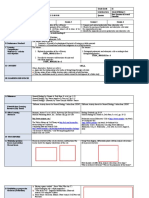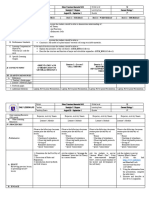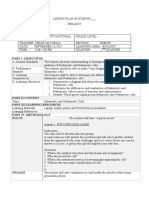School FULLBRIGHT COLLEGE Grade Level GRADE 11/12
GRADES 1 to 12
Teacher Angela Delos Santos Learning Area Biology 1
DAILY LESSON LOG
Teaching Dates and Time September 5-9, 2022- 7:30- Quarter 1ST QUARTER
5:00pm
MONDAY TUESDAY WEDNESDAY / ICL THURSDAY FRIDAY
(Independent
Cooperative Learning)
I. OBJECTIVES
A. Content Standard he learners The learners demonstrate The learners The learners
demonstrate an and understanding of cell demonstrate an demonstrate an
understanding of cell structure and function understanding of understanding of cell
Theory Prokaryotic vs Types
Eukaryotic
Cells
B. Performance Standard The learners shall able The learners shall able to construct a cell construct a cell
to construct a 3D model construct a 3D model of a membrane membrane
of a plant / animal / plant / animal / bacterial model from model from
bacterial cell using cell using recyclables indigenous or indigenous or
recyclables materials. materials. recyclable recyclable
materials materials
C. Learning Competencies/Objectives Explain the postulates The learners describe the The learners distinguish The learners shall be
write the LC code for each of the cell theory STEM_ structure and function of prokaryotic and eukaryotic classify different cell
BIO11/12 Ia-c-1 major and subcellular cells according to their types (plant/animal
organelles. distinguishing features. tissues)
STEM_BIO 11/12-I ac-2 STEM_ BIO11/12 Ia-c-3 and specify the
function(s) of each
STEM_BIO11/12-
Ia-c-4
D. Specific Objectives At the end of 60 At the end of 60 minutes of At the end of 60 minutes of At the end of 60
(cognitive/affective/psychomotor) minutes of the lesson the lesson the grade 11 the lesson the grade 11 minutes of the lesson
the grade 11 learners learners are expected to learners are expected to do the grade 11 learners
are expected to do the do the following with at the following with at least are expected to do the
following with at least least 80% proficiency 80% proficiency level. The following with at least
80% proficiency level. level. The grade 11 grade 11 learners will able 80% proficiency level.
The grade 11 learners learners will able to: to: The grade 11 learners
will able to: will able to:
a.) Describe the basic a.) Define and A.) Identify and
a.) Identify the components of a cell and differentiate define the
three postulates their functions between prokaryotic different cell
of the cell and eukaryotic cells. types found in
theory. (Cognitive) b.) perform a hands-on plant and
( Cognitive) b.) Construct a Venn activity to model the animal tissues.
Diagram to show parts that structural B.) Develop skills in
b.) Draw accurate and are common to both and differences between accurately
labeled diagrams of parts that are only found in prokaryotic and identifying and
observed cells. either plant or animal cells eukaryotic cells. labeling cell
(Psychomotor) (Psychomotor) c.) Give the importance types on
c.) Give the of understanding of prepared slides
b.) Express importance of the diversity and or images.
curiosity and understanding of the complexity of life by C.) Express
interest in structure and function of studying the curiosity and
learning about cells in biology. different cell types. interest in
cells and the cell (Affective) learning about
theory. different cell
( Affective) types and their
classification
within plant and
animal tissues.
II. CONTENT Cell theory Cell Structure and function Prokaryotic vs. Eukaryotic Cell Types
III. LEARNING RESOURCES Laptop, Projector, Printer, Internet Connectivity, Web sources, Cartolina, Marker, Double Sided Tape, Bond Paper, White Board, Chairs &
Table.
A. Revisiting Concepts 1. Reviewing what is three
postulates of cell.
2. Reviewing the definition
of cell.
3. What are the
importance of cell in our
daily lives?
B. Internet Resources
IV. PROCEDURES
A. Reviewing previous lesson or The teacher will ask The teacher will ask: Q and A about the previous Q and A about the
presenting the new lesson questions like: *What is cell? lesson. previous lesson.
*Who are the people *What are the types of
behind the discovery of cell?
the cell theory? *Do you know their parts
*What are the cell and functions?
theories?
B. Establishing purpose for the lesson Activity: Activity: Activity: Activity:
C. Presenting examples/instances of *Discuss cell theory *Explain cell and its Explain the differences Explain the different
the new lesson * Explain the discovery importance between prokaryotic and cell type that found in
of the cell theory *Differentiate plant and eukaryotic cells. plant and animal
animal cells based on their tissues
parts
D. Discussing new concepts and Lecture-Discussion Lecture-Discussion Lecture-Discussion Lecture-Discussion
practicing new skills #1.
E. Discussing new concepts and ACTIVITY: BY GROUP ACTIVITY: REPORTING ACTIVITY: Triad .ACTIVITY: Role play
practicing new skills #2. ROLE PLAY 3D prokaryotic and
eukaryotic model using a
clay.
F. Developing mastery ACTIVITY: Check Me ACTIVITY: ACTIVITY: ACTIVITY:
(leads to formative assessment) Enumeration and definition True or false Enumeration and
Directions: Put a check Directions: Enumerate and Definition
in a box if the Define each
statement is correct.
G. Finding practical applications of ACTIVITY: Self- ACTIVITY: Self- ACTIVITY: Self-assessment ACTIVITY: Self-
concepts and skills in daily living. assessment assessment assessment
H. Making generalizations and Cell Theory *3 major cell parts Prokaryotic and Eukaryotic Animal Cells
abstractions about the lesson. *All organisms are 1. Nucleus differences Plant Cells
made up of cell 2. Cell membrane Bacterial Cells
*Cells are the basic unit 3. Cytoplasm
of life
*Cells come from pre-
existing cell
I. Evaluating learning 20 items pen and paper 20 items pen and paper 20 items pen and paper 20 items pen and
test test test paper test
J. Additional activities for application ASSIGNMENT: ASSIGNMENT: ASSIGNMENT: ASSIGNMENT:
or remediation
Directions: Directions: Directions: Directions:
Write a reflection about Write a brief explanation Write a reflection about Write a reflection about
what you have learned for each organelle's what you have learned what you have learned
about cell theory. structure and function. about prokaryotic and about cell types.
eukaryotic.
V. REMARKS
VI. REFLECTION
A. No. of learners who earned 80% in
the education
B. No. of learners who require
additional activities for remediation
who scored below 80%
C. Did the remedial lesson work? No.
of learners who have caught up with
the lesson.
D. No. of learners who continue to
require remediation.
E. Which of my teaching strategy
worked well? Why did these work?
F. What difficulties did I encounter
which my principal or supervisor can
help me achieve?
G. What innovation or localized
materials did I use/discover which I
wish to share with other teachers?
For improvement, enhancement and/or clarification of any DepEd material used, kindly submit feedback to bld.tld@deped.gov.ph

































































































